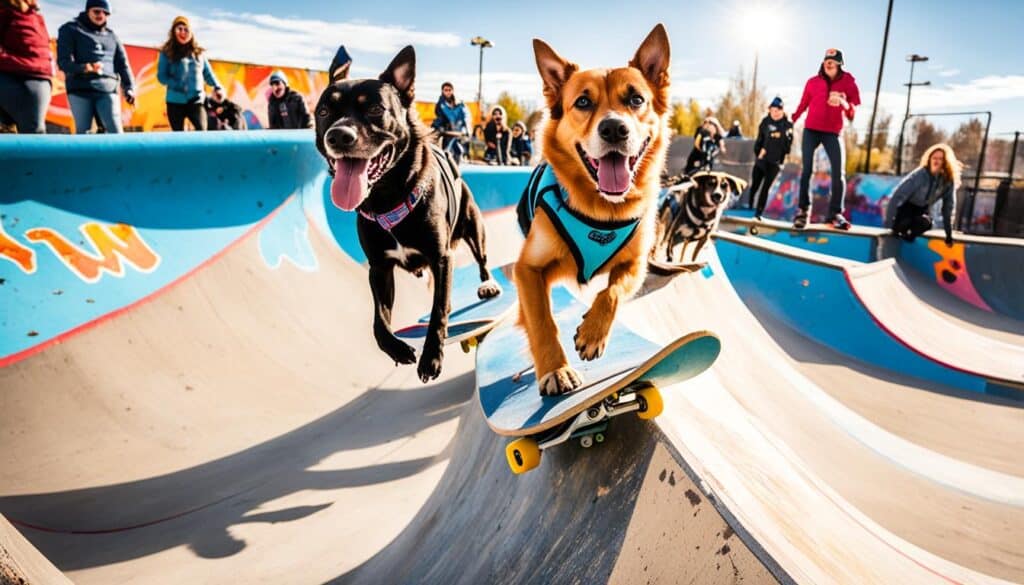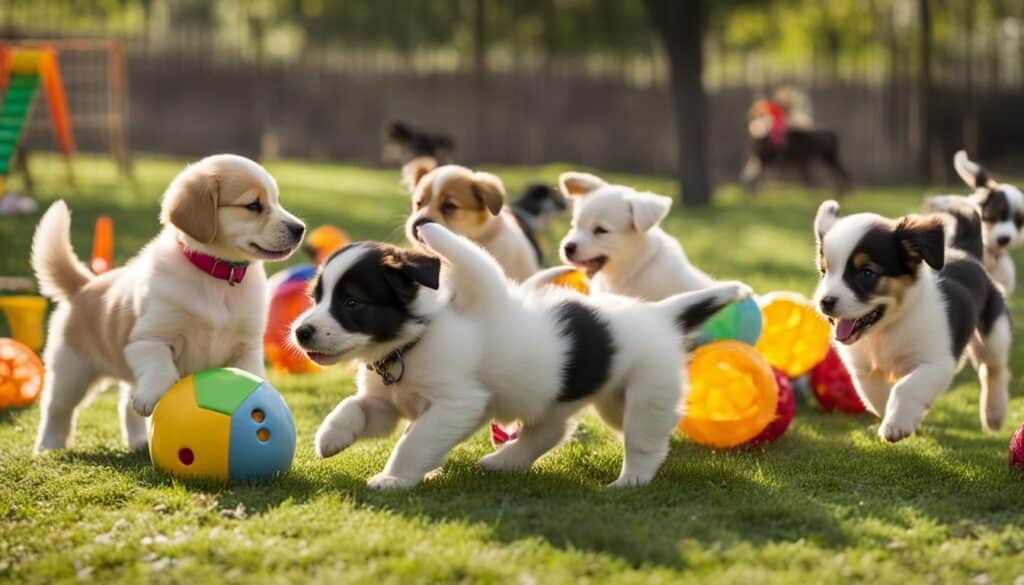Welcome to the exciting world of skateboarding dogs! If you’ve ever marveled at the incredible tricks performed by these four-legged athletes, then this ultimate guide is for you. Whether you’re a dog owner looking to train your furry friend or simply a fan of adorable and awe-inspiring videos, this guide has everything you need to know about the fascinating world of skateboarding dogs.

Key Takeaways:
- Learn how to train your dog to skateboard and master impressive tricks.
- Discover the suitable dog breeds for skateboarding and the factors to consider beyond breed.
- Understand the step-by-step process to teach your dog to skateboard, ensuring their safety and enjoyment.
- Explore the fantastic tricks performed by famous skateboarding dogs throughout history.
- Uncover the physical, mental, and bonding benefits of skateboarding for dogs.
Can Dogs Learn to Skateboard?
Skateboarding is often considered a human sport, but did you know that dogs can also learn to skateboard? It may seem unlikely, but with the proper training and guidance, many dogs have become skilled skateboarders. In this section, we will explore the possibility of dogs learning to skateboard and discuss important factors that can contribute to their success.
What breeds are most suited for skateboarding?
While any dog can learn to skateboard, certain breeds tend to excel in this activity. Bulldogs, including the iconic English Bulldog and the famous French Bulldog, are known for their low center of gravity, muscular build, and balanced temperament, making them natural candidates for skateboarding. These breeds’ sturdy physique and strong legs make them well-suited for this activity.
However, it’s essential to note that breed alone is not the only criteria considered skateboarding skills. Factors beyond breed come into play when determining a dog’s aptitude for skateboarding.
Factors beyond breed
In addition to breed, a dog’s personality and trainability are crucial factors that influence their ability to learn and enjoy skateboarding. Dogs that are naturally adventurous and enjoy exploring new activities tend to skateboard more easily. Trainable dogs that respond well to positive reinforcement techniques are also more likely to succeed in learning this unique skill.
Age and skateboarding
Is it better to start training dogs to skateboard when they are young? Starting dogs young can be advantageous when teaching them to skateboard. Puppies have a natural curiosity and enthusiasm for learning, making the training process more enjoyable for both the pup and the owner. As dogs grow older, they may become more set in their ways and less open to new experiences, making it more challenging to introduce them to skateboarding.
Starting dogs young also allows them to develop muscle strength, coordination, and balance for skateboarding. They can build on their foundational skills and progress to more advanced maneuvers as they mature.
| Top Skateboarding Dog Breeds | Trainability Level |
| Bulldogs | High |
| Border Collies | High |
| Golden Retrievers | Medium |
| Australian Shepherds | Medium |
| Labrador Retrievers | Medium |
| Boxers | Medium |
How to Teach Your Dog to Skateboard: Step-by-step training guide
Teaching your dog to skateboard can be a fun and rewarding experience for you and your furry friend. With the right approach and consistency, any dog can learn to skateboard. In this step-by-step training guide, we will go through the process of teaching your dog to skateboard, starting from the basics and progressing to more advanced tricks.
The importance of positive reinforcement
Positive reinforcement is critical when training your dog to skateboard. You can motivate your dog by using treats, praise, and rewards and make the learning process enjoyable. Dogs respond to positive reinforcement, so remember to reward them for their efforts and progress.
Mastering simple commands
Before starting skateboarding, you must ensure your dog has mastered simple commands such as “stay” and “come.” These commands will help you maintain control over your dog while skateboarding and ensure their safety. Practice these commands consistently before moving on to the next steps.
Getting comfortable on the board
The first step in teaching your dog to skateboard is to get them comfortable with the board. Start by introducing the skateboard in a stationary position. Allow your dog to sniff and investigate the board, rewarding them with treats and praise for positive behavior. Gradually encourage your dog to step onto the board and stand still. This will help them become familiar with the sensation of being on a skateboard.
Learning to push
Once your dog is comfortable standing on the skateboard, it’s time to teach them how to push off and gain momentum. Start by holding a treat before your dog and encouraging them to push the skateboard with their front paws while keeping their back legs on the ground. Repeat this motion until your dog understands how to make the skateboard forward.
Introduction to gentle slopes
As your dog becomes more confident on the skateboard, gradually introduce them to gentle slopes. Find a shallow incline where your dog can practice skateboarding downhill. Start by standing at the bottom of the hill and encouraging your dog to skateboard towards you. Use treats and praise to reward their progress. It’s essential to start with gentle slopes to ensure your dog’s safety and build their confidence.
Advanced tricks
Once your dog has mastered the basics, you can teach them more advanced tricks on the skateboard, such as turning and jumping. Use consistent commands and positive reinforcement to guide your dog through these tricks. Remember to be patient and give your dog time to understand and practice each new skill.
Safety first
When teaching your dog to skateboard, safety should always be a priority. Ensure your dog wears appropriate safety gear, such as a dog-specific skateboard helmet and pads to protect their joints. Also, choose controlled environments for skateboarding sessions avoiding busy roads or potential hazards. By prioritizing safety, you can ensure a positive and enjoyable skateboarding experience for you and your dog.
| Training Steps | Training Tips |
| 1. Introduce the skateboard | – Use treats and praise to create positive associations with the skateboard. – Allow your dog to investigate the board before encouraging them to stand on it. |
| 2. Teach basic commands | – Ensure your dog can reliably follow commands like “stay” and “come” to maintain control during skateboarding sessions. |
| 3. Get comfortable on the board | – Gradually introduce your dog to the skateboard, rewarding them for calmly standing on it. – Practice short sessions to prevent any anxiety or discomfort. |
| 4. Learn to push | – Use treats and encouragement to teach your dog how to push the skateboard forward with their front paws. |
| 5. Try gentle slopes | – Find a shallow incline where your dog can practice skateboarding downhill. – Start with small distances and gradually increase as your dog becomes more skilled. |
| 6. Teach advanced tricks | – Use consistent commands and positive reinforcement to guide your dog through turning and jumping. – Break down each trick into smaller steps for easier learning. |
| 7. Prioritize safety | – Ensure your dog wears appropriate safety gear, including a skateboard helmet and pads. – Choose controlled environments for skateboarding sessions to minimize risks. |
Skateboarding Dogs: Amazing Tricks
Skateboarding dogs are not only capable of cruising on a board but also wowing audiences with their incredible tricks. These talented canines showcase their skills with jaw-dropping stunts that leave spectators in awe. From performing
Famous skateboarding dogs throughout history
One of the most iconic skateboarding dogs is Tillman the Bulldog. Tillman gained fame for his impressive skateboarding skills and became a beloved figure in the skateboarding community. His ability to easily ride a skateboard and perform tricks made him a pioneer in skateboarding dogs. Tillman’s incredible talent and charismatic personality led to appearances on various television shows and even the Guinness World Records.

Potential for dog skateboarding competitions
The popularity of skateboarding dogs has given rise to the potential for dog skateboarding competitions. These events allow talented dogs nationwide to showcase their skills and compete for titles. Dog skateboarding competitions create a platform for dog owners and trainers to come together, celebrate their shared passion, and appreciate the unique abilities of these four-legged athletes. As the sport continues to gain recognition and attract more participants, the future of dog skateboarding competitions looks promising, offering exciting opportunities for both dogs and their human companions.
The Benefits of Skateboarding for Dogs
Skateboarding isn’t just a fun activity for humans—it can also benefit our furry friends! From physical exercise to mental stimulation and bonding opportunities, skateboarding for dogs offers a range of advantages that can contribute to their overall well-being.
Physical exercise
One of the primary benefits of skateboarding for dogs is the physical exercise it provides. As dogs ride and navigate the skateboard, their muscles engage, promoting strength, coordination, and balance. Continuous skateboard movement also helps improve cardiovascular health and keeps dogs fit and active. Whether cruising down the sidewalk or performing tricks at the park, skateboarding allows dogs to burn off energy and maintain a healthy weight.
Mental stimulation and challenge
Skateboarding offers more than just physical benefits—it also provides mental stimulation and a fun challenge for dogs. Balancing on the skateboard and performing tricks requires focus, problem-solving skills, and coordination. By engaging their minds and bodies, skateboarding helps dogs stay mentally sharp and prevents boredom. The mental stimulation provided by skateboarding can also contribute to reducing unwanted behaviors by redirecting their energy into a positive outlet.
A fun bonding activity for dog and owner
Skateboarding with your dog can be a fantastic bonding experience. It creates an opportunity for quality time spent together, strengthening the bond between dog and owner. As you teach your dog to skateboard and learn tricks together, you’ll develop a shared interest and a unique way of communicating. The joy and laughter shared during skateboarding sessions can deepen the emotional connection and create lasting memories.
Building confidence in dogs
Skateboarding can be an excellent confidence-building activity for dogs. As they conquer new tricks and challenges, dogs gain a sense of accomplishment and self-assurance. Over time, the successful execution of skateboarding maneuvers can boost their confidence levels and overall self-esteem. This newfound confidence can extend beyond skateboarding and positively impact other areas of their lives, making them more resilient and adaptable.

Overall, skateboarding provides numerous benefits for dogs. It offers physical exercise, mental stimulation, and a fun bonding activity for dogs and owners, and it helps build confidence in dogs. So, grab a skateboard, harness up your furry friend, and embark on an exciting journey together!
| Benefits of Skateboarding for Dogs | |
| Physical exercise | Strengthens muscles and improves cardiovascular health |
| Mental stimulation and challenge | Engages the mind and prevents boredom |
| A fun bonding activity for dog and owner | Strengthens the emotional connection and creates memories |
| Building confidence in dogs | Boosts self-assurance and resilience |
Where to Find Dog-Friendly Skateparks
If you’re eager to hit the skatepark with your dog and showcase their impressive skateboarding skills, finding a dog-friendly skatepark that welcomes our furry friends is essential. Luckily, various online resources are available to help you locate the perfect skatepark for you and your canine companion.
Online resources for locating skateparks
Online platforms and websites can be valuable tools when searching for dog-friendly skateparks. These resources provide information on skatepark locations, ensuring you can find a suitable spot for dogs. Here are some popular online resources to consider:
- Skatepark Project: The Skatepark Project website offers a comprehensive database of skateparks across the United States. You can easily search for skateparks that welcome dogs in your area, ensuring enjoyable skateboarding experience.
- Go Skate: Go Skate is another valuable online resource providing a directory of skateparks nationwide. Their user-friendly platform allows you to filter your search to find dog-friendly skateparks near you.
- Local skateboarding communities: Connecting with local skateboarding communities through social media platforms, such as Facebook groups or Reddit forums, can be a great way to discover dog-friendly skateparks in your area.
Dog skateboarding etiquette
When enjoying a skateboarding session with your dog at a dog-friendly skatepark, following proper etiquette to ensure a positive experience for everyone involved is essential. This includes showing respect for other skaters and maintaining cleanliness within the park.
Respect for other skaters is crucial. Always be mindful of other skateboarders and give them space as they navigate the park. Communicate with fellow skaters to ensure a safe and enjoyable environment.
Additionally, cleaning up after your dog is imperative. Be a responsible pet owner by bringing waste disposal bags and promptly cleaning up any messes to maintain the cleanliness of the skatepark and demonstrate respect for the community.
| Etiquette Guidelines | Explanation |
| Respect other skaters | Show consideration for other skaters by giving them space and communicating effectively. |
| Clean up after your dog | Ensure the skatepark remains clean and hygienic by promptly cleaning up after your dog. |
Conclusion
In conclusion, skateboarding dogs have taken the world by storm, captivating audiences with their impressive tricks and adorable antics. Throughout this ultimate guide, we have explored the fascinating realm of skateboarding dogs, covering everything from the breeds that are suited for skateboarding to step-by-step training techniques.
Key takeaways from this guide include the importance of positive reinforcement in teaching dogs to skateboard, mastering simple commands for better control, and gradually introducing dogs to the skateboard in a safe and controlled environment. Skateboarding is a thrilling activity for dogs and provides numerous benefits. It offers physical exercise, mental stimulation, and a fun bonding experience for both the dog and their owner. Additionally, skateboarding can help build confidence in dogs, allowing them to conquer new challenges and develop their skills.
Always prioritize safety, invest in proper gear, and respect other skaters at dog-friendly skateparks. So, grab your skateboard and get ready to hit the pavement with your talented canine partner!

